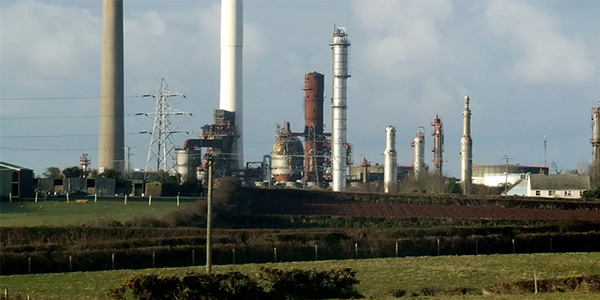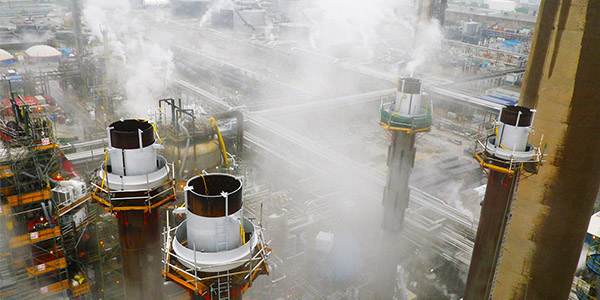Chimney Scaffolding
Scaffolding is an important component of constructing, maintaining, and demolishing industrial chimneys. Industrial chimneys are located in various industry sectors, such as power generation, refineries, and manufacturing plants. Industrial chimneys are tall and complicated structures, thus requiring scaffolding to be specialized. Scaffolding provides a safe work environment along with an important structural connection to the chimney during maintenance operations. The right scaffolding solution will help an industry minimize risk, lower down-time and effectively complete a project; all the more valued in harsh environments. In this blog, we will discuss several scaffolding types used for industrial chimneys, as well as the safety requirements, and provide case studies of where scaffolding was used successfully.

Types Of Industrial Chimney Scaffolding
Suspended Scaffolding
- Overview: A suspended scaffold consists of platforms, suspended from the top of a chimney by ropes or cables, with height adjustment made by the worker.
- Applications: Perfect for maintenance applications involving inspection, painting or small repairs where access to the full chimney height is required.
- Advantages: Offers excellent flexibility and movement for workers, allowing access to a high chimney. A suspended scaffold allows work to occur at any work height without the need to constantly disassemble and reassemble the scaffold.
Fixed scaffolding
- Description: Fixed scaffolding is a stable and long-term scaffolding structure that is anchored at the ground and on the chimney.
- Application: Used above all during the construction of new chimneys or during major renovations in which a robust and secure platform is required.
- Stability: Has a high load-bearing capacity meaning it is suitable for heavy duty work such as brickwork, structure repair, or placing large items.
Mobile Scaffolding
- Definition: A wheeled scaffold for easy movement around the chimney site.
- Uses: Mobile scaffolding is well-suited for regular maintenance and inspection tasks that need frequent repositioning, such as cleaning or inspections associated with structural integrity.
- Ideal Situations: Mobile scaffolding is especially useful in facilities where there are multiple chimneys or when work is needed to access different areas of the chimney in a shorter timeframe. Scaffolding of this kind saves time, it is about convenience, and improves efficiency.
Detailed Project Case Studies
Chimney Maintenance At A Refinery:
- Project Background And Requirements
- Location: Rotterdam, Netherlands
- Chimney Height: 80 meters
- Project Duration: 4 months
- Scaffolding Type: Suspended Scaffolding

Project Challenges and Solutions:
- Access to Confined Areas: The refinery's layout required scaffolding that could be easily adjusted to reach confined spaces around the chimney.
- Suspended scaffolding provided the necessary flexibility, allowing workers to access different sections of the chimney with ease.
- Minimizing Disruption: Work was scheduled during off-peak hours to minimize disruption to refinery operations, with scaffolding platforms designed to be quickly raised or lowered as needed.
- Safety Measures: Rigorous safety checks were conducted daily, with workers using full body harnesses and safety lines.
Outcome:
- Completion Time: On schedule.
- Safety Record: No safety incidents reported.
- Client Feedback: Commended the minimal impact on operations and the efficiency of the scaffolding system.
Demolition Of Industrial Chimneys
- Project Background And Requirement
- Project Location: Mumbai, India
- Chimney Height - 60 Meters.
- Project Timeframe - 3 Months
- Scaffolding Type - Cantilever Scaffolding

Project Challenges And Solutions
- Limited Ground Access: The chimney was located in an industrial area of high density with little space for ground scaffolding. Cantilever scaffolding was installed by anchoring it to the chimney to provide a safe working platform, giving workers access to work on the chimney structure.
- Safety Issues: The work, was identified as the removal of hazardous materials, necessitating a scaffolding system that was capable of supporting excessive loads and protecting workers. Additional safety measures were take such as adding netting to catch debris and reinforcing decking to support workers and material.
- Timing and Coordination: The work was planned with measured schedules to not impact the ongoing neighboring business, working with local authorities to secure the safety of the area.
Outcome
- Completion Time: Completed on schedule.
- Safety Record: No incidents reported, with all hazardous materials safely removed.
- Client Feedback: Highlighted the project’s smooth execution and the scaffolding’s adaptability to the challenging environment.
Benefits Of Using Professional Fire And Laboratory Cleanup For Industrial Stacks
Reduction in Accident Management and Risk
- Safety Assurance - We find that fire and laboratory safety firms locate and implement the hazards for personnel and environments including staying from fall hazards, valid anchoring and tie-offs, and structures that practice disarray inspections.
- Controlled and Managed Inventory - Trained persons and supervisors only allow scaffold assembly, scaffold materials are sorted for regulations, and illegal reductions have addressed the likelihood of errors and getting hurt little in the process of scaffolding setup and being on-site with scaffold management if conditions impact production plan costs
Cost Savings and Schedule Reductions
- Cost Savings with Strong Structure - When professional scaffold hire for ladder access each component of scaffolding materials allows the project to eliminate 35% of time and labor as scope eliminated to organize this site scaffolding.
- Non-career schedule - All scaffold that is organized eliminates the job for carry and can cause a waste of time if not planned.
Improved Project Timelines
- Streamlined Processes: Professional scaffolding services enable faster project completion through the use of specialized equipment and experienced teams who can quickly set up and adapt scaffolding as needed.
- Minimized Disruption: Efficient scaffolding solutions reduce the impact on surrounding operations, ensuring that projects are completed on schedule with minimal interruptions.
Better Access to Challenging Areas
- Custom Solutions: Professional scaffolding companies offer customized designs to access difficult-to-reach areas of industrial chimneys, such as tight spaces, high altitudes, or complex structures.
- Adaptability: Whether the project involves new construction, maintenance, or demolition, professional scaffolding solutions are adaptable to the unique requirements of each chimney, ensuring that every part of the structure can be safely and efficiently accessed.
Conclusion
In the construction, maintenance, or demolition of industrial chimneys, chimney scaffold tower is a vital component that provides safety, efficiency, and a successful project outcome. Industrial scaffolding solutions deliver improvements to the safety protocols, enjoy cost-effective planning, and become even better as each project is successfully completed on time. The ability to maneuver in tough to reach spaces, minimize risk, and follow rigorously enforced safety standards is formidable without a scaffolding solution meticulously tailored to the hazards presented with the industrial chimney project. With the proper scaffolding services, workers are kept safe and the long-term integrity and performance of industrial chimneys will be preserved to ensure future successful project outcomes. The success of industrial chimney projects will depend on expert scaffolding service and related support as a fundamental driver of success.
FAQ
How do you ensure safety when working on tall chimneys?
- Safety is ensured through strict adherence to international safety standards, regular inspections, secure anchoring, and the use of fall protection systems like guardrails and harnesses.
How long does it take to scaffold an industrial chimney?
- The time required depends on the chimney's height and complexity, but typically ranges from a few weeks for smaller projects to several months for larger ones.
Can scaffolding be used in extreme weather conditions?
- Yes, but precautions are necessary. Scaffolding must be secured and inspected regularly, and work is often scheduled to avoid severe weather conditions like high winds or heavy rain.


